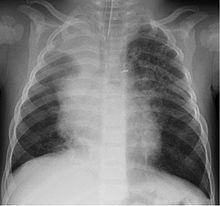SUMMARY
Human bocavirus a human pathogenic virus, often targeting the respiratory and gastrointestinal systems. The virus belongs to the genus Bocaparvovirus and the Parvoviridae family. Young children are more at risk of developing the disease, as young as six months. Diagnosis of the disease is not readily available and requires PCR. Because it is a newly described disease, much research is yet to be done and the full capacity of the disease it yet to be discovered.
FACT TABLE
| Formal binomial name of microbe: | Family Parvoviridae; genus Bocavirus |
| Gram stain (gram positive, gram negative or neither): | Viruses can’t be seen via gram stain |
| Is the microbe mobile or immobile? | Immobile on its own |
| Primary habitat? | n/a |
| Can the organism infect humans? | Yes |
| Can the organism infect other species? If so, which ones. | This species of Bocaparvovirus affects only humans |
| Number of infections per year in the US | Not recorded |
| Number of infections per year in the world | Not recorded. No diagnostic tests or medical treatments |
DESCRIPTION
Human bocavirus is typically referred to as bocavirus or HBoV. It is a small single stranded DNA non- enveloped virus. The identified strains of human bocavirus are HBoV, HBoV-2, and HBoV-3. It is genetically and structurally similar to bovine parvovirus with canine minutevirus. The virus was first identified in 2005.

Clinically, bocavirus can be identified with a polymerase chain reaction test. It is difficult to assess if an individual has the virus due to the lack of availability of the PCR test. It is often detected in children who are diagnosed with lower respiratory tract infection or diarrhea symptoms. Other symptoms often seen in children infected with bocavirus are cough, fever, runny nose, and vomiting. It is unknown if these symptoms are caused by bocavirus or not. There is no treatment available for bocavirus. Currently, there is no vaccine for the human bocavirus. It is also not clearly understood how the virus spreads.

It is not widely understood how the virus develops or spreads due to the lack of information available. There is research being done on the virus. This information will be clinically relevant because the virus effects infants and young children. The virus is found in children in all parts of the world and has an unclear prognosis. Future research will indicate if the virus works to make individuals prone to other diseases or if the virus is manifested after the presence of another disease.
RECENT NEWS
Recent research has shown how DNA damage signaling is required for the replication of the Human bocavirus 1 DNA in dividing HEK293 cells. These cells need to be damaged for the infection as well as the spread of this virus.
Younger patients struggling with lower respiratory problems are more likely to have a high human bocavirus virus load. The peak age of patient with high virus load is 6–24 months.
Research has shown the importance of the nonstructural protein NP1 in the expression of the viral capsid protein. This is highly efficient in gene delivery to human airway epithelia.
SOURCES
“Human bocavirus: Current knowledge and future challenges”; ncbi.nlm.nih.gov; https://www.ncbi.nlm.nih.gov/pmc/articles/PMC5075545/
“Bocavirus Infection”; medicinenet.com; https://www.medicinenet.com/bocavirus_infection/article.htm#bocavirus_facts
“Pediatric Bocavirus”; medscape.com; https://emedicine.medscape.com/article/1355393-overview